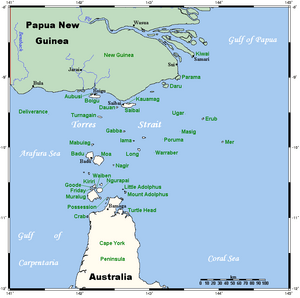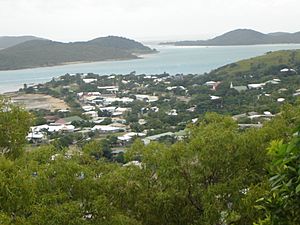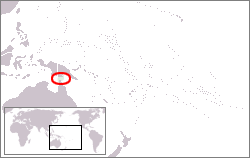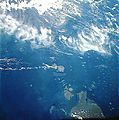Torres Strait facts for kids
The Torres Strait is a narrow sea located between Australia's Cape York Peninsula and New Guinea. It's about 150 kilometres (93 miles) wide. This sea is full of islands, coral reefs, and sandbanks.
The strait is named after a Spanish sailor, Luís Vaz de Torres, who sailed through it in 1606. There are about 240 islands in the strait, but only 17 of them have people living on them. Around 6,800 Torres Strait Islanders live on these islands. However, about 42,000 Islanders now live on the Australian mainland.
The islands are part of Australia and belong to Queensland. They are managed from Thursday Island by the Torres Strait Regional Authority. The Torres Strait is the only part of Australia that shares a border with another country, New Guinea.
Contents
Geography of the Strait
The Torres Strait is an important pathway for ships. However, it's very hard to sail through safely. This is because the water is not very deep, and there are many reefs and islands.
The islands in the strait are different types:
- Some islands near New Guinea are low and flat. They are made from soil washed down by rivers.
- The hilly islands in the west are made of granite. They were once the tops of mountains. They became islands when the sea levels rose about 8,000 years ago.
- Islands in the middle are mostly coral cays. These are small, low islands made of sand and coral.
- The islands in the east were formed by submarine volcanos. These volcanoes grew above the ocean's surface.
In 2009, the islanders asked the Australian government for money to build new sea walls. Some islands are very low. Rising sea levels and big tides have caused many areas to flood. This flooding has damaged homes and put salt into the fresh water supply. People might have to leave two of the mud islands, Boigu and Saibai, if the rising sea levels continue to cause problems.
The Torres Strait Islanders
The people who live on the islands are called the Torres Strait Islanders. They are Melanesian people, similar to the Papuans of New Guinea. The Islanders have their own special culture and a long history. They traded with the Papuans to the north and the Australian Aboriginal people for thousands of years.
The Islanders speak two main languages:
- Kala Lagaw Ya (also known as Kalaw Kawaw Ya, Kawalgaw Ya, or Kulkalgaw Ya)
- Meriam Mir
There is also a language called Brokan (Broken), or Torres Strait Creole. This language is a mix of different languages and Islander words. It started when Islanders began working on ships looking for pearls in the 1860s.
History of the Torres Strait
About 8,000 years ago, the sea level was much lower. The Torres Strait was not covered by water then. This meant people and animals could walk between New Guinea and Australia. Some animals and birds, like the cassowary, are found in both New Guinea and Queensland. Other animals, like pigs, arrived in New Guinea after the sea levels rose. They could not cross to Australia once the land bridge was gone.
There is evidence that people have lived on the Torres Strait islands for at least 2,500 years. It's likely people lived there much earlier. However, rising sea levels would have covered older sites.
European Explorers Arrive
The first European known to sail through the strait was Luís Vaz de Torres, a Spanish or Portuguese sailor. He was second-in-command of a Spanish journey that sailed from Peru in 1605. After the main ship went back to Mexico, Torres continued to the Moluccas and then to Manila. He sailed along the south coast of New Guinea. He might have seen Cape York Peninsula in Australia, but we don't have proof. Torres wrote a letter to the Spanish king about his discoveries, but this letter was kept secret until 1762.
In 1769, a Scottish geographer named Alexander Dalrymple was translating Spanish letters found in the Philippines. He read Torres's letter about a passage south of New Guinea. Dalrymple wrote a book about voyages and discoveries in the South Pacific. This book made many people interested in the idea of an unknown continent. Dalrymple named the strait after Torres.
This led Captain James Cook to go on another voyage. In 1770, Cook sailed through the strait after exploring the east coast of Australia. He landed on Possession Island and claimed all the land of Australia for Britain.
As explorers like James Cook, William Bligh, and Matthew Flinders made maps of the strait, more ships started to use it. They sailed from Sydney to India or Asia. But it was still dangerous, and many ships crashed on the reefs. A Scottish woman, Barbara Thompson, was the only person saved when her ship "America" hit a reef in 1842. Islanders rescued her, and she lived with them on Prince of Wales Island for five years. Then, another ship took her back to Sydney.
Trade and Pearling
An important pearling business operated in the strait from the 1860s until about 1970. Pearling brought many skilled divers from different countries, especially Japan.
Missionaries Arrive
The London Missionary Society arrived on Erub (Darnley Island) in 1871. The islanders still celebrate the arrival of the missionaries as "The Coming of the Light." It is a holiday every year on the islands.
Government and the Flag
Even though some Torres Strait islands are very close to New Guinea, they were taken over by Queensland in 1879. Queensland was a British colony at that time. In 1978, Australia and Papua New Guinea made an agreement. This agreement set the correct position of the sea border in the Torres Strait.
The Torres Strait also has its own flag. It was designed by Bernard Namok from Thursday Island. The flag has five stripes: green for the land, blue for the sea, and black for the people. It also has a big white Dari, which is a traditional headdress. A five-pointed star represents the five main island groups. In 1995, it officially became a flag of Australia.
World War II in the Strait
During World War II, Horn Island in Torres Strait became Australia's most northern air base. It is about 150 kilometres (93 miles) north of Cape York. In 1940, two large runways were built there. Thousands of Allied aircraft used this base.
Horn Island was attacked by Japanese planes eight times in 1942. This made it the most attacked place in Queensland. Conditions on the island were tough for the soldiers. They had poor food, not enough water, diseases, and Japanese attacks. Today, the airport is still working as the main airport for far north Queensland. It is now a tourist spot, famous for its fishing.
Torres Strait in Books
Jules Verne wrote about the Torres Strait in his novel, Twenty Thousand Leagues Under the Sea. In the story, it was a dangerous place where the submarine "Nautilus" got stuck for a short time.
Images for kids
-
The Torres Strait seen from space – Cape York Peninsula is at the bottom; several of the Torres Strait Islands can be seen strung out towards Papua New Guinea to the north.
See also
 In Spanish: Estrecho de Torres para niños
In Spanish: Estrecho de Torres para niños






